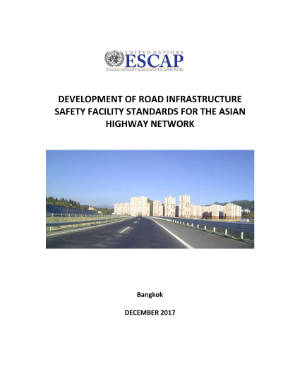Development of Road Infrastructure Safety Facility Standards for the Asian Highway Network

Road safety is a sustainable development issue that needs greater attention as road traffic fatalities and injuries place a significant burden on national economies. The Asia-Pacific region accounted for 58% of the global road traffic deaths in 2013. Between 2010 and 2013, while 16 Asian Highway member countries were successful in reducing road fatalities, others failed to do so. The seventh Goal of the “updated Regional Road Safety Goals and Targets for Asia and the Pacific, 2016-2020” emphasizes on developing the Asian Highway network as a model of road safety.
Studies show a strong correlation between infrastructure design and road safety and road engineering and design can influence the severity of the crashes. In this regard, the Annex II to the Intergovernmental Agreement on the Asian Highway Network which entered in to force on 4 July 2005 includes design standards for the Asian Highway Network. However, the design standard does not provide adequate guidance on road infrastructure safety facilities.
As one of the initiatives to address the road safety problem on the Asian Highway Network, the ESCAP secretariat, in association with the Korea Expressway Corporation conducted a study on the development of technical standards on road infrastructure safety facilities for the Asian Highway Network. A detailed literature review on existing standards for infrastructure element design and specification to address road safety in the Asian Highway member countries and other international sources was conducted. A list of 36 road infrastructure safety facilities was prepared. Detailed information on road infrastructure safety practices was collected from five participating countries. A survey was conducted to assess the prevalence, types and design standards of road safety facilities in the Asian Highway member countries in end 2015. The international road assessment programme (iRAP) methodology was used to illustrate how relative risk levels would change if road infrastructure safety facilities were added to the existing Asian Highway standard. It could be concluded that there is potential to promote the use of a broader range of road infrastructure safety facilities for the Asian Highway Network.
The study suggested that the Intergovernmental Agreement on the Asian Highway Network provides an adequate institutional platform for providing guidance to member countries in a number of areas and could further be used for promoting a coordinated approach to the development and adoption of standards of road infrastructure safety facilities. The study emphasizes on providing guidance to the Asian Highway member countries through a dedicated new annex to the Intergovernmental Agreement on the Asian Highway Network. In this regard, proposed mandatory minimum design standards of road infrastructure safety facilities for the Asian Highway Network which could serve as a draft Annex II bis “Asian Highway Design Standards for Road safety” to the Intergovernmental Agreement on the Asian Highway Network; and related design guidelines of road infrastructure safety facilities which could serve as a recommended practice for the Asian Highway Network have been developed. The study recommended the Asian Highway member countries to consider adopting and implementing technical design standards of road infrastructure safety facilities towards improving road safety on the Asian Highway Network.